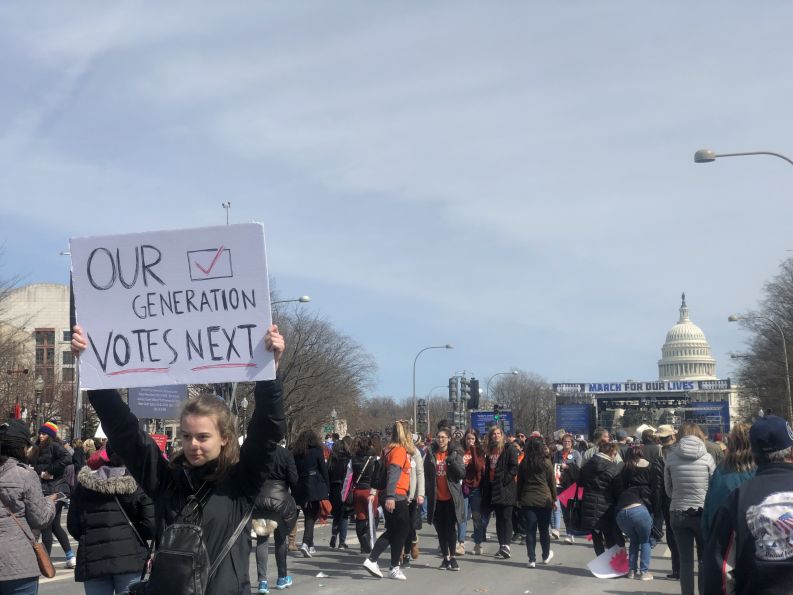
The March for Our Lives may have taken place on March 24, 2018, but the impact will last longer than that day.

“The march is not the climax of this movement, it is the beginning,” Marjory Stoneman Douglas student Cameron Kasky said to the more than 800,000 estimated attendees. “It is the springboard off of which my generation and all who stand with us will jump into a safer future.”
One of the major messages of the march was for all eligible supporters to vote in the 2018 midterm elections. The speeches sent a message to senators and members of Congress that gun control will be a issue that voters care about in these elections.
“To the politicians that believe that their right to own a gun comes before our lives: get ready to get voted out by us, the future,” Marjory Stoneman Douglas student Sarah Chadwick said.
Midterm voter turnout has traditionally been statistically lower than turnout for general elections. According to the US Census, 41.9 percent of voting-aged citizens voted in the 2014 midterm election. In the 2016 general election, 61.4 percent of voting-aged citizens voted.
The students that spoke at the march emphasized that this drop off would be tolerated no more. They focused on voters being able to make educated decisions at election time.
“Through every single walkout, we need to make sure that you can register to vote or pre-register to vote,” Marjory Stoneman Douglas student Ryan Deitsch said. “Then we will educate. We will be going around the country until these elections and therefore after until we can tell every man, woman and child what is real, what is going on, and we need to make sure that everyone knows what is actually happening in their backyards and abroad. We will register, we will educate and, when it comes down to it, we will vote.”
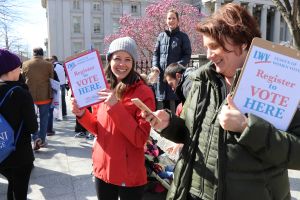
In the 2016 election, 50 percent of 18-29 year olds voted. In the future, this number may be higher. Young people are focusing on developing political knowledge early so that they can vote when they are eligible.
“My friends and I might still be 11— we might still be in elementary school— but we know life isn’t equal for everyone and we know what is what and wrong,” Naomi Wadler, a fifth grade student from Alexandria, Va. said. “We also know that we stand in the shadow of the capital and we know that we have seven short years until we, too, are allowed to vote.”
On the streets, marchers carried signs bearing messages such as “single issue voter” and “Our generation votes next.” Voter registration tables were prominent. In between speeches, the crowd chanted “vote them out” and “We will vote.”
An unnamed Democratic party member drew a crowd on the street and encouraged individuals not to lose the momentum from the march.
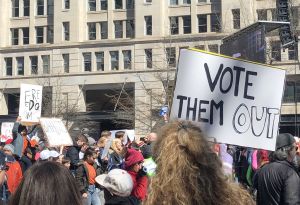
“You’re doing great work today, but you gotta keep sustaining it until election day,” the demonstrator said. “Every single day, ask yourself the question: what did I do to help somebody commit to vote, commit to register to vote or commit to get out to vote?”
Outside of voting, an important message was advocacy. Speakers encouraged the crowd to contact their representatives and find out their views on these issues
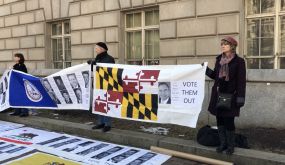
“Now we need to come together on all fronts and push aside those that divide us. Now we need to get on the phone and call our representatives and push them to stop incompetence and take action,” Marjory Stoneman Douglas student Alex Wind said. “Now we need to educate ourselves on which politicians are truly working for the people and which ones we want to vote out, because at the end of the day, bullets do not discriminate, so why should we?”
An option for those that want to lobby for an issue is to organize a meeting at their representative’s local or Washington D.C. office.
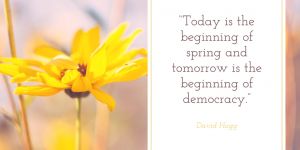
“Our elected officials have seen American after American drop from a bullet, but instead of waking up to protect us, they have been hitting to snooze button. We’re here to shake them awake,” Marjory Stoneman Douglas student Jaclyn Corin said. “Each Congressman has a local office in their district, so pay them a visit or organize a town hall. Have them hear you out because they work for us. If they still won’t meet with you, remind them that you invented their opponent, ’cause we all know they’ll show up then.”



